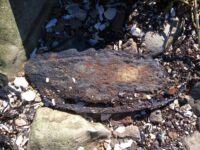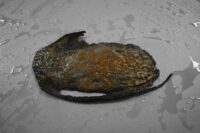 A 3,000-year-old toddler’s shoe discovered on a foreshore in North Kent may be the oldest shoe in the British Isles. The previous record-holder, found in a quarry in Somerset in 2005, was a mere 2,000 years old. The tiny shoe may also be the smallest Bronze Age shoe discovered anywhere in the world.
A 3,000-year-old toddler’s shoe discovered on a foreshore in North Kent may be the oldest shoe in the British Isles. The previous record-holder, found in a quarry in Somerset in 2005, was a mere 2,000 years old. The tiny shoe may also be the smallest Bronze Age shoe discovered anywhere in the world.
It was discovered by archaeologist Steve Tomlinson while mudlarking last September on a beach he prefers not to name. The ovoid piece of leather looked to him like the sole of a small shoe and he and fellow archaeologist Emily Brown speculated that it could be early Medieval based on the type of shoe construction. Following a hunch that this little object could be something very old and meaningful, Tomlinson sent it to Scotland for carbon dating. The results of the radiocarbon analysis found that their speculation had been far too restrained. The shoe is not early Medieval, but rather dates to between 888 and 781 B.C., the Late Bronze Age period.
 The shoe is 15 cm (six inches) long which would make it a UK toddler size 7 (US toddler size 8-8.5), the size worn by children about two or three years old. A micro-CT scan of the shoe revealed it was made of at least two layers, maybe three. An X-ray found that the bottom of the shoe is imprinted with a woven textile pattern, indicating it was wrapped in fabric for a long time.
The shoe is 15 cm (six inches) long which would make it a UK toddler size 7 (US toddler size 8-8.5), the size worn by children about two or three years old. A micro-CT scan of the shoe revealed it was made of at least two layers, maybe three. An X-ray found that the bottom of the shoe is imprinted with a woven textile pattern, indicating it was wrapped in fabric for a long time.
During the last few months the shoe has been conserved by Dana Goodburn Brown (pictured), an accredited Archaeological Conservator at DGB Conservation.
She says: “This late Bronze Age shoe is awaiting further possible scientific investigations and conservation stabilisation treatment. If allowed to dry out with no treatment it would likely to shrink and become very brittle. Further analysis might be to identify the type of animal the leather was made from, or indeed different animal leathers might have been used to construct the child’s shoe. […]
“A further look at the textile impression and pattern of the woven material as seen on the X-radiograph taken by James Elliot at the Canterbury Christchurch Diagnostic Radiography Dept might reveal more information about the textile associated with the shoe. The type of leather might be determined by looking at the pattern of pores for the hair follicles, if visible, and/or DNA analysis. Whether and how the leather was treated to last (tanning), or rawhide might be discovered through chemical analysis. If adhesive was used to stick the layers together, may also be found.
When the scientific analyses are complete, the shoe is expected to go the British Museum.
I hope it is of some consolation to my mother that 3,000 years from now someone may finally find that little white and red checked shoe I threw out the window of a moving vehicle and enshrine it in one of the world’s foremost museums.